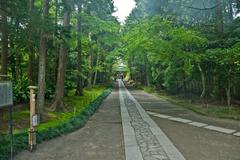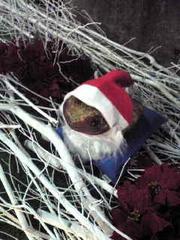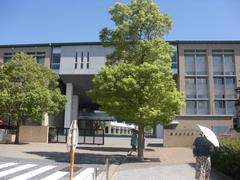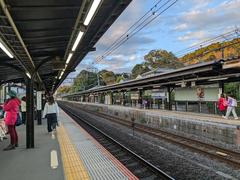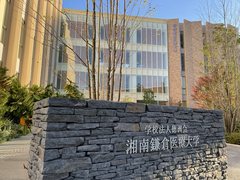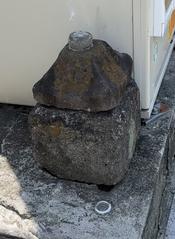
Kamakura Museum of National Treasures: Complete Visiting Guide
Date: 04/07/2025
Introduction: History and Significance
The Kamakura Museum of National Treasures is a cornerstone of Japan’s cultural preservation, located within the revered Tsurugaoka Hachimangu Shrine precinct in Kamakura. Established in 1928, the museum was created in response to the catastrophic Great Kantō Earthquake of 1923 to safeguard invaluable artifacts from the Kamakura and Muromachi periods—eras that mark Kamakura’s zenith as Japan’s political and cultural epicenter from the late 12th to 14th centuries.
Housing approximately 4,800 objects, including five National Treasures and many Important Cultural Properties, the museum grants visitors an exceptional view into the artistic, religious, and social dynamics of medieval Japan. Its collection spans Buddhist sculptures, samurai armor, calligraphy, ceremonial implements, and more. The building’s architecture, inspired by the ancient Shōsōin treasure house at Tōdai-ji, seamlessly merges traditional Japanese aesthetics with modern seismic resilience.
Whether you are a history buff, art enthusiast, or traveler, this comprehensive guide will equip you with essential information about visiting hours, ticketing, accessibility, nearby attractions, and special events. For further information, visit the Official Kamakura City Museum Page and Tsurugaoka Hachimangu Shrine Official Site.
Table of Contents
- Introduction
- Historical Development and Museum Origins
- Architectural Features
- Visiting Information
- Collection Highlights
- Visitor Experience and Services
- Nearby Attractions
- Special Events and Educational Programs
- Frequently Asked Questions (FAQ)
- Practical Tips
- Visual Resources
- References and Useful Links
Historical Development and Museum Origins
Foundation and Purpose
The Kamakura Museum of National Treasures (鎌倉国宝館, Kamakura Kokuhōkan) was established in April 1928 to protect Kamakura’s cultural heritage, particularly after the loss and damage caused by the 1923 earthquake (Official Kamakura City Site). Artifacts were initially collected from local temples and shrines, ensuring their safety and public accessibility.
Wartime and Postwar Renewal
During World War II, the collection was evacuated to Kushikawa village for protection. The museum closed briefly in 1945 but reopened the following year, resuming its role as a guardian of regional heritage. Ongoing renovations and expansions have enhanced its facilities and collection over the decades.
Evolving Collection
Today, the museum boasts roughly 4,800 objects, including items designated as National Treasures and Important Cultural Properties, with a focus on Buddhist art, samurai culture, and courtly life. Influences from Chinese Song and Yuan dynasties can also be seen throughout the collection (Kamakura City Official).
Architectural Features
Main Building
Designed by Okada Shin’ichirō, the main structure features a raised floor and tiled roof, echoing the style of the Shōsōin treasure house. Its reinforced concrete ensures both preservation and earthquake safety, while the spacious exhibition hall (nearly 600 square meters) allows for immersive displays (Kamakura City Cultural Properties).
Annex and Modernization
An annex connected by a second-floor walkway houses offices and conservation labs. The building was designated a Registered Tangible Cultural Property in 2000. The architecture balances tradition with modernity, featuring subdued lighting and minimalist interiors to highlight the artifacts.
Visiting Information
Hours and Closures
- Opening Hours: 9:00 AM – 4:30 PM (last admission at 4:00 PM)
- Closed: Mondays (or the following day if Monday is a national holiday), New Year’s holidays, and during exhibition change periods
Please check the official website for updates during special exhibitions.
Ticketing
- Adults: 400–800 yen (check current rates; special exhibitions may affect pricing)
- High School/University Students: 150–400 yen
- Elementary/Junior High Students: Free or discounted
- Group Discounts: Available for groups of 20 or more
Tickets are typically purchased at the entrance. Online booking is not always available, but check the official ticketing page for updates.
Accessibility
The museum is wheelchair accessible, with ramps and elevators. Accessible restrooms are on-site. Contact staff in advance for special assistance.
Directions
- From JR Kamakura Station: 12–15 minute walk via Komachi Street
- By Bus: Alight at Shirahata Shrine or Maruyama Inari Shrine near Tsurugaoka Hachimangu
- By Car: Parking available near Tsurugaoka Hachimangu Shrine (limited, especially on weekends/holidays)
Collection Highlights
- Buddhist Sculptures: Including statues of Amida Nyorai, Kannon, Jizo Bosatsu, and the Twelve Heavenly Generals (Kamakura Kokuhōkan Collection)
- Samurai Armor and Weapons: Yoroi, kabuto, swords, and other artifacts reflecting Kamakura’s military heritage
- Calligraphy and Paintings: Sutra scrolls, emaki, and kakemono by renowned monks and artists
- Ceramics and Lacquerware: Tea bowls, incense burners, and decorative arts
- National Treasures and Important Cultural Properties: Including the Mandala Enki and Writing Box with maki-e and mother-of-pearl inlay
Visitor Experience and Services
- Peaceful Atmosphere: The museum provides a contemplative environment, ideal for appreciating art and history
- Layout: Organized by genre—sculpture, painting, crafts, calligraphy, and historical documents
- Labels & Language: Most labels are in Japanese, with English translations on key artifacts; English pamphlets available
- Rest Areas: Benches throughout; restrooms on-site
- Photography: Generally prohibited, especially for National Treasures and Important Cultural Properties
Nearby Attractions
- Tsurugaoka Hachimangu Shrine: Kamakura’s most important Shinto shrine
- Komachi Street: Famous for souvenirs and snacks
- Engakuji Temple & Kencho-ji Temple: Major Zen temples nearby
- Great Buddha (Kamakura Daibutsu): Accessible by bus or train
- Hokokuji (Bamboo Temple), Hase Temple: Other notable historic sites within easy reach
Special Events and Educational Programs
- Temporary Exhibitions: Rotating themed displays throughout the year
- Workshops & Lectures: For all ages, fostering understanding of Kamakura’s heritage (Kamakura City Event Calendar)
- Guided Tours: Available on request or via local guides
- Digital Initiatives: Virtual tours, high-res images, and 3D models (Kamakura Kokuhōkan Digital Archive)
- Community Involvement: Museum participates in festivals and supports a volunteer network (Kamakura Kokuhōkan Friends)
Frequently Asked Questions (FAQ)
Q: What are the museum’s opening hours?
A: 9:00 AM – 4:30 PM, last admission 4:00 PM. Closed Mondays and New Year holidays.
Q: How much are tickets?
A: Adults 400–800 yen, discounts for students. Confirm on the official site.
Q: How do I get tickets?
A: Purchase at the entrance; online booking may be available for special exhibitions.
Q: Is the museum accessible for visitors with disabilities?
A: Yes, with ramps, elevators, and accessible restrooms.
Q: Are guided tours available?
A: Yes, by request or via local guides.
Q: Can I take photos?
A: Photography is restricted in most galleries. Follow posted signs and staff directions.
Practical Tips
- Wear comfortable shoes—Kamakura’s streets and shrine grounds require walking
- Bring cash for tickets and purchases; some shops may not accept cards
- Dress appropriately for the season
- Visit on weekdays or early mornings for a quieter experience
Visual Resources
- Virtual tour and maps on the official website
- High-quality images of the collection and architecture available online
- Suggested alt text for social sharing:
- “Kamakura Museum of National Treasures main building exterior”
- “Buddhist sculptures inside Kamakura Museum”
- “Map of Kamakura Museum and surroundings”
References and Useful Links
- Official Kamakura City Museum Page
- Kamakura Museum Collection Highlights
- Kamakura Kokuhōkan Digital Archive
- Tsurugaoka Hachimangu Shrine Official Site
- Kamakura historical sites
- Kamakura City Event Calendar
- Kamakura Kokuhōkan Friends
- Agency for Cultural Affairs
- Kamakura Museum Tickets
Conclusion and Call to Action
The Kamakura Museum of National Treasures is a gateway to Japan’s medieval splendor, offering a meticulously curated collection within an architectural gem. Its proximity to other Kamakura historical sites makes it a vital stop for anyone seeking to immerse themselves in Japanese culture.
Stay updated on visiting hours, ticketing, and events via the official website and consider downloading the Audiala app for virtual tours and additional content. For a deeper dive, explore related Kamakura historical sites and cultural resources.
Your journey into Japan’s national treasures begins here—where centuries of history meet present-day exploration.
Sources
- Kamakura Museum of National Treasures: Visiting Hours, Tickets & Historical Insights, 2025, Official Kamakura City Site (https://www.city.kamakura.kanagawa.jp/)
- Cultural Significance and Visitor’s Guide to the Kamakura Museum of National Treasures, 2025, Kamakura City Official (https://www.city.kamakura.kanagawa.jp/kokuhoukan/)
- Kamakura Museum of National Treasures: Your Complete Guide to Visiting Hours, Tickets, and Highlights, 2025, Kamakura City Cultural Properties (https://www.city.kamakura.kanagawa.jp/)
- Kamakura Museum of National Treasures Visiting Hours, Tickets, and Visitor Guide, 2025, Kamakura Museum Official Website (https://www.city.kamakura.kanagawa.jp/)


